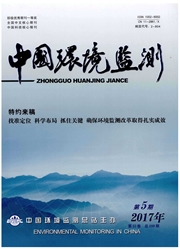

 中文摘要:
中文摘要:
通过2010年4月采集环鄱阳湖区地表尘土样品,对其重金属污染物进行分析研究,并运用美国环保局推荐的健康风险评价模型对所引起的健康风险做了初步评价。结果表明,地表尘土中Cd、Cr、Cu、Pb、Zn平均含量分别为0.909、74.64、78.37、78.33、213.62 mg/kg,5种重金属平均含量均高于江西土壤背景值。重金属非致癌风险Pb〉Cr〉Cu〉Cd〉Zn,均小于非致癌风险阈值1,对人体不会造成健康危害;致癌重金属致癌风险Cr〉Cd,均低于癌症风险阈值,表明不具有致癌风险。暴露模型计算表明,重金属慢性每日平均暴露量为手-口接触摄入量〉皮肤吸收量〉吸入空气量,经手-口直接摄入是地表尘土暴露风险的主要途径。
 英文摘要:
英文摘要:
Through collecting the surface dust samples in the area around the Poyang Lake on April 2010, the heavy metal pollutants were analyzed, and by analyzing the health risk evaluation model which recommended by US EPA, the health risk was evaluated preliminarily, the results show that the average content of Cd, Cr, Cu, Pb and Zn in the surface dust are 0. 909, 74. 64, 78.37, 78.33, 213.62 mg/kg, respectively. The average level of those five kinds heavy metal is higher than the background values of the soil in Jiangxi. Non-carcinogenic risk of heavy metals: Pb 〉 Cr 〉 Cu 〉 Cd 〉 Zn, which less than the threshold value of 1, is no harm to humans; the carcinogenic risk of carcinogenic heavy metals: Cr 〉 Cd, which below the threshold value of cancer risk, show non-carcinogenic risk. According to the exposure model calculations, the chronic daily intake of heavy metals : intake of hand-mouth contacting 〉 skin absorption 〉 amount of air inhaled, and the direct intake of hand- mouth contact behavior is the main way of exposure risk of the surface dust.
 同期刊论文项目
同期刊论文项目
 同项目期刊论文
同项目期刊论文
 期刊信息
期刊信息
